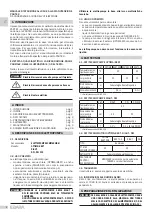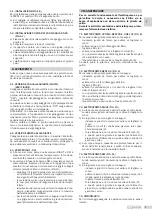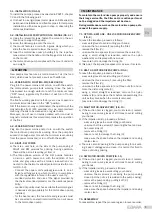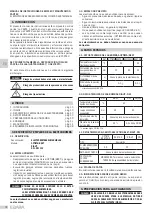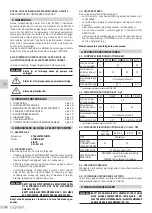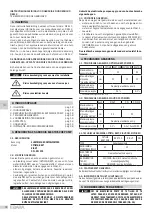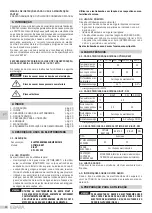
5
EN
5.1. INSTALLATION (FIG.1-5)
To install the pumps, proceed as directed in PART 1, chapter
7.2 and in the following point:
a) It is best to use rigid pipes (metal pipes on DW series) for
permanent installations and flexible pipes for temporary
installations, with sizes as given in chap. 4, observing the
distances illustrated.
5.2. INSTALLING DW PUMP WITH DN 50 FLANGE (FIG. 6-7)
a) Using the relevant screws, fasten the mount on the sur
-
faces due to support the pump;
b) screw the delivery pipe onto the mount;
c) the mount features a rod with a guide along which you
slide the hook required to lower the pump;
d) lower the motor-driven pump, holding it by the rope fas
-
tened around the handle, until the flange slots into place
on the mount;
e) the motor-driven pump couples with the mount under its
own weight.
6. STARTING
New pumps may feature a small amount of oil (the food
kind), which does not present a source of health risk.
6.1. VERSION WITH FLOAT (MA-MS) (SEE FIGURE)
Plug into the power mains and/or turn on with the switch:
the motor-driven pump starts working. Once the pump
has sucked in enough water to reach the minimum level
(“OFF” level), regulated by the float, it will turn off auto
-
matically.
The float’s working position is factory set so as to assure a
minimum immersion level in the “OFF” position.
NB: If the liquid is overly contaminated, the operation of the
magnetic-type float (MS versions) may be compromised,
meaning it needs to be cleaned on a regular basis.
Moreover, do not use in liquids polluted with iron dust or
magnetic material as this would compromise the operation
of the float.
6.2. VERSION WITHOUT FLOAT
Plug into the power mains and/or turn on with the switch:
the motor-driven pump starts working. Once the pump has
sucked in enough water to reach the minimum level, unplug
from the power mains and/or turn off with the switch.
6.3. RIGHT - DW PUMPS
a) There is a vent hole on the side of the pump casing of
RIGHT and DW versions for priming. During operation,
there will be a small recycling jet from it.
b) The three-phase version of the DW pumps features
a 3-wire + earth power cord with the addition of two
white and grey wires with a smaller cross-section con
-
nected to the thermal overload protector inside the mo
-
tor (FIG. 13).
–
Connect the power cord’s yellow/green wire to an ef
-
ficient earthing system, which must be in compliance
with the regulations in force in the user’s country;
–
overload protection and use of the signal provided by
the thermal overload protector are the user’s responsi
-
bility;
–
overload trip units must have suitable thermal-magnet
-
ic devices set appropriately for the motor-driven pump
installed;
–
for the heat sensor, the two white and grey wires must
be connected to an electrical circuit that can cut power
to the motor-driven pump.
7. MAINTENANCE
To maintain the motor-driven pumps properly and ensure
their long service life, the filter and/or suction port must
not be clogged and the impeller must be clean.
During maintenance work on the motor-driven pumps, dis-
connect the power supply.
7.1. OPTIMA - BEST ONE - ONE VOX MOTOR-DRIVEN PUMP
(FIG. 8)
To reach the impeller, proceed as follows:
– wear work gloves to avoid cutting your hands;
– unscrew the two screws (1) securing the filter;
– remove the filter (2);
– unscrew the two spacers (3) and remove the volute (5);
– using a small straight screwdriver, remove the nylon
washers (4) and replace with new ones;
– take care not to damage the O-ring (6).
At this point, the impeller is exposed: make sure it is clean.
7.2. BEST 2-5 MOTOR-DRIVEN PUMPS (FIG. 9)
To reach the impeller, proceed as follows:
– wear work gloves to avoid cutting your hands;
– unscrew the three screws (1) securing the filter;
– remove the filter (2);
– unscrew the three spacers (4) and three nuts (5) and re
-
move the distancing plate (3);
– using a small straight screwdriver, remove the nylon
washers (6) and replace them before reassembling the
unit as they break when the volute is removed;
– take care not to damage the O-ring (7).
7.3. RIGHT MOTOR-DRIVEN PUMP (FIG. 10)
a) If the suction port is clogged, you must clean it, remem
-
bering to wear work gloves at all times to avoid cutting
your hands;
b) If the impeller is dirty, proceed as follows:
– wear work gloves to avoid cutting your hands;
– unscrew the three screws (1) securing the feet and suc
-
tion cover side (2)
– remove the O-ring (3);
– take care not to damage the O-ring (3);
– make sure the space between the impeller and casing
is also clean.
c) There is a small opening in the pump casing for air vent
-
ing; keep it unclogged and clean. It is normal for fluid to
come out during priming.
7.4. DW MOTOR-DRIVEN PUMP (FIG. 11)
a) If the suction port is clogged, you must clean it, remem
-
bering to wear work gloves at all times to avoid cutting
your hands;
b) If the impeller is dirty, proceed as follows:
– wear work gloves to avoid cutting your hands;
– unscrew the six screws (1) keeping the pump casing
closed (not the nut as it is welded to the pump casing);
– remove the pump casing, pulling it off (2);
– remove the O-ring (3);
– take care not to damage the O-ring (3);
– make sure the space between the impeller and casing
is also clean.
7.5. REASSEMBLY
To reassemble, repeat the procedure given in reverse order.
Содержание BEST ONE
Страница 36: ...36...
Страница 37: ...37 35 35 35 35 35 35 34 36 OPTIMA MS...
Страница 39: ...39 FIG 8 OPTIMA BEST ONE BEST ONE VOX FIG 9 BEST 2 3 4 5 FIG 10 RIGHT FIG 11 DW DW VOX FIG 12 FIG 13...


